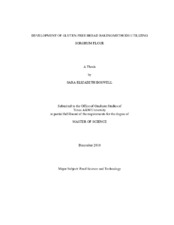| dc.contributor.advisor | Rooney, Lloyd W. | |
| dc.creator | Boswell, Sara Elizabeth | |
| dc.date.accessioned | 2012-02-14T22:18:50Z | |
| dc.date.accessioned | 2012-02-16T16:20:28Z | |
| dc.date.available | 2012-02-14T22:18:50Z | |
| dc.date.available | 2012-02-16T16:20:28Z | |
| dc.date.created | 2010-12 | |
| dc.date.issued | 2012-02-14 | |
| dc.date.submitted | December 2010 | |
| dc.identifier.uri | https://hdl.handle.net/1969.1/ETD-TAMU-2010-12-8911 | |
| dc.description.abstract | Increasing diagnosis and awareness of celiac disease and gluten intolerance has
created a need for developing improved quality gluten-free sandwich breads. Sorghum is
a naturally gluten-free grain with ideal baking qualities that is underutilized in the
gluten-free baking industry. Research is needed on developing gluten-free breads
utilizing sorghum flour that could be used in future research and commercial production.
Three objectives were tested. Objectives evaluated feasibility of using egg white
foam with leavening agents in yeast-free bread, optimum mixing time in a laboratory
control bread utilizing sorghum flour, and maximizing the amount of sorghum flour that
could be used in the control formulation. Four comparisons were tested for yeast-free
breads and 5 were compared for yeast breads. Volume, hardness, and color were
measured using 15 replications. Environmental Scanning Electron Microscopy (ESEM)
was performed on selected treatments to evaluate crumb structure.
Utilizing egg white foam for gluten-free breads produced acceptable volume,
color, crumb structure and hardness compared to commercial gluten-free controls. Using
egg white foam eliminates proofing time with increased production speed. Increasing mixing time in gluten-free yeast breads significantly (P<0.05)
improved specific volume and overall loaf volume without negatively affecting crumb
hardness in 10 and 15 minute mixing treatments. Crumb structure was significantly
improved between 5 and 15 minute treatments. Evaluation with ESEM showed reduced
clumping of ingredients in the crumb and thinner air cell walls. Specific volume and loaf
volume were significantly (P<0.05) higher in 15 minute mixing (2.13 cm^3/g; 1845 cm^3)
versus the commercial comparison (2.00 cm^3/g; 923 cm^3). Optimum mixing for yeast
bread was 15 minutes and optimum percentage of sorghum used in the flour blend was
60 percent. Increasing the use of commodity grade gluten-free decorticated white sorghum
flour will reduce cost of specialty milled ingredients.
In future studies mixing for 15 minutes using the laboratory yeast bread
formulation containing 60 percent sorghum should be used as the research control as it
provided consistent optimum results. | en |
| dc.format.mimetype | application/pdf | |
| dc.language.iso | en_US | |
| dc.subject | gluten-free | en |
| dc.subject | sorghum | en |
| dc.subject | bread | en |
| dc.subject | baking methods | en |
| dc.subject | yeast-free | en |
| dc.subject | gluten | en |
| dc.subject | celiac | en |
| dc.subject | white sorghum | en |
| dc.title | Development of Gluten-Free Baking Methods Utilizing Sorghum Flour | en |
| dc.type | Thesis | en |
| thesis.degree.department | Soil and Crop Sciences | en |
| thesis.degree.discipline | Food Science and Technology | en |
| thesis.degree.grantor | Texas A&M University | en |
| thesis.degree.name | Master of Science | en |
| thesis.degree.level | Masters | en |
| dc.contributor.committeeMember | Turner, Nancy D. | |
| dc.contributor.committeeMember | Awika, Joseph M. | |
| dc.type.genre | thesis | en |
| dc.type.material | text | en |


